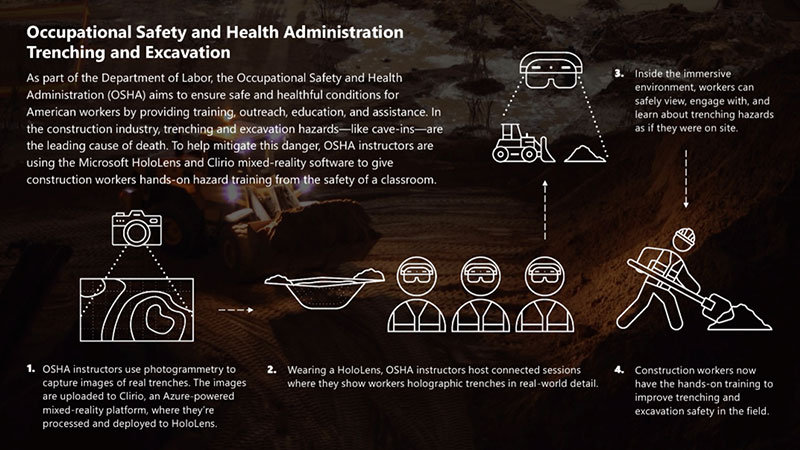The Occupational Safety and Health Administration uses mixed reality to improve worker safety during trench excavation
Downloads
As part of the Department of Labor, the Occupational Safety and Health Administration (OSHA) aims to ensure safe and healthful conditions for American workers by providing training, outreach, education, and assistance. In the construction industry, trenching and excavation hazards—like cave-ins or collapsed trenches—are the leading cause of death. To help mitigate this danger, OSHA instructors are using the Microsoft HoloLens to give trench safety inspectors immersive, hands-on hazard training from the safety of a classroom.
A hole lot of hazards
In construction, trenching and excavating are risky but necessary jobs. You can’t lay pipes, electrical cables, or telephone wires into the ground without digging a hole first. When excavating, it’s basically you against gravity, and any number of things can upset the delicate balance keeping a trench’s walls intact—e.g., vibrations from construction activity, unstable soil, weather, equipment stationed too near an edge. Without the proper safety measures, deadly cave-ins can occur within minutes. Teaching trench safety inspectors to recognize hazards is the best way to keep trenches upright and people unharmed. But according to Eric Reinhardt, an Occupational Safety and Health Instructor at the OSHA Training Institute in Arlington Heights, IL, onsite instruction has its own set of challenges. “I’ve found that in my trenching and excavation course, the way students learn best is by hands-on training. Unfortunately, we can’t just go out and dig holes in any parking lot.”
Occasionally, OSHA instructors led field trips to actual trench sites, which raised another concern: safety. “Any time you have a group of students near holes in the ground, you need to make sure the entire class stays far away from the trench. There are a lot of health and safety concerns with the stability of any ground surface area,” says Anthony Towey, Director of the OSHA Training Institute.
OSHA needed a way to give students a real-world learning experience without the real-world risk and found a solution in augmented reality.

Building a better, safer environment
OSHA partnered with Clirio, a software studio that designs custom 3D and immersive experiences and a member of Microsoft’s Mixed Reality Partner Program. Together, OSHA and Clirio decided to create an Azure-powered, mixed-reality app to simulate the exact type of environment students would experience in the field. HoloLens, a hands-free, mixed-reality headset providing high-resolution image quality, was a natural vehicle to display OSHA’s immersive new world.
OSHA instructors visited a construction site and used photogrammetry technology to capture images of trenches, forming the basis of their augmented learning reality. Gerald Magnusson, Co-founder and Head of Product at Clirio, further explains how they brought these static images to life: “The software allows content creators to drag and drop their data into our Azure cloud instance. Then, it’s processed and deployed to HoloLens. From there, users can log on using Azure Active Directory to interact with their data safely and securely, without any concerns of that proprietary information being compromised to anyone else.”
The app consists of six different scenes using realistic and immersive photogrammetry graphics to show variables like ground conditions, hazards, safety equipment, and best practices for mitigating risk. Sophisticated sound design and animation add to the lifelike experience.
“With the HoloLens, we can show hazards in a safe, realistic environment. We can put a tractor too close to the edge or show fissures inside the trench. I jokingly told a student ‘be careful’ while he was walking around and he abruptly stopped—it was that realistic.”
Reaching more students with less effort
With the HoloLens, teaching hazard recognition to America’s construction workers has become simpler and safer. Previously, training required either a field trip to an excavation site or hands-off textbook learning. Now, instructors and students can strap on a HoloLens to view and engage with a trench from the safety of a lab or classroom. Using locally hosted sessions, instructors can invite multiple students into a session where they’re all immersed in—and can engage with—the same environment at the same time.
“Whenever you teach somebody something, it’s one thing to tell them. It’s one thing to show them. And it’s another thing to let them do it. We can actually go into a trenching and excavation environment that’s as close as they’re going to get in the field.”
Paving the way to a safer future
For Reinhardt, one of the most exciting things about using the HoloLens was thinking outside the box to build a solution. “With this new technology, we were excited about reaching people across the United States in new ways to teach an important subject. This is a great learning tool.”
Towey sees the app’s benefits extending beyond federal and state OSHA compliance officers and into the private sector. “There are thousands and thousands of construction contractors out there who could use this training. And now they’ll be able to do it in a safe environment, where they can practice and make mistakes.” With the help of cutting-edge technology, OSHA is continuing to save lives and improve the health and safety of American workers everywhere.
Recommended Videos
Veterans Health Administration uses mixed reality to provide cutting-edge solutions
Learn about how the VHA, Microsoft, Medivis, and Verizon are collaborating to deliver advanced healthcare solutions for our veterans using cutting-edge technologies.
Explore our Technology Explainer Video page for overview videos explaining the emerging technology of today, including AI, Machine Learning, and more.
